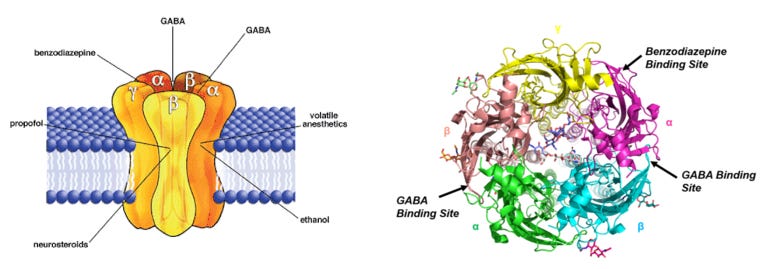Know Your GABA-A Receptor Subunits
Many psychiatric drugs and supplements affect GABA, the brain’s main inhibitory neurotransmitter. But some have different effects than others. Why? This is rarely a productive question to ask in psychiatry, and this situation is no exception. But if you persist long enough, someone will eventually tell you to study GABA receptor subunits, which I am finally getting around to doing.
GABA-A is the most common type of GABA receptor. Seen from the side, it looks like a bell pepper; seen from above, it looks like a tech company logo.
 I never claimed to be profound, only accurate. Source here.
I never claimed to be profound, only accurate. Source here.
GABA-A is “heteropentameric”, which means it is made of five potentially-different subunits. Typically, a GABA-A is made of two alpha subunits, two beta subunits, and one extra (usually a gamma) subunit. There are different kinds of alpha, beta, and gamma subunits, named things like “alpha-1”, “alpha-2”, and so on.
So for example, the most common kind of GABA receptor is called α1β2γ2, which means it’s made of two α1 units, two β2 units, and one γ2 unit. This naming system assumes that both of the α units (and so on for β units) will be of the same type, which is usually true although occasionally there are some exceptions. Here are some other common kinds of GABA-A receptors (source):
 What does it mean when they don’t have a number after the Greek letter, as in α2βγ2? I don’t know!
What does it mean when they don’t have a number after the Greek letter, as in α2βγ2? I don’t know!
Most research seems to have focused on the alpha subunits. Here is a very, very rough oversimplified list of pharmacological effects associated with each alpha subtype:
α1: Sleepiness.
α2: Anti-anxiety
α3: Anti-anxiety
α4:???
α5: Memory? Dependence?
α6:???
Benzodiazepines are among the most classic GABA-affecting drugs. They seem to affect only receptors with alpha subunit types 1, 2, 3, and 5. You might predict that they would make people sleepy, relieve anxiety, affect memory, and cause dependence, all of which is true.
(I’m cheating by saying “affect memory”. Benzodiazepines generally make memory worse. But other studies have shown that blocking α5 makes memory better. I don’t have a good explanation for the discrepancy, or for why we even have that lever. Maybe it’s one of the receptors God added in to prevent us from becoming too powerful. Someday we will find a selective α5 blocker, gain perfect memory, and storm the gates of Heaven.)
Insomnia treatment is a very lucrative industry, so maybe you want to make people sleepy without doing all the other stuff. A quick look at the table above suggests you want something selective for receptors with the α1 subunit. In fact, this is zolpidem - aka Ambien, one of the most popular sleeping pills. It doesn’t quite live up to this promise; for one thing, people often seem to develop tolerance to it, which its developers originally hoped wouldn’t happen. Also, it sometimes makes people see hallucinatory walruses. I don’t know which GABA receptor subunit that is.
But anxiety treatment is also lucrative, so it would be nice to have an α2- and α3-selective drug. If everything worked according to the textbooks - which it never does - this would relieve anxiety without causing sleepiness or dependence. Many of the studies I read from 2010 - 2012 touted the potential of a chemical called TPA-023, which was supposed to be exactly this and which seemed promising in preliminary studies. After about 2012, TPA-023 fell off the face of the Earth, so I assume some pharma company found some kind of dealbreaker without telling the rest of us.
Whenever people look for some drug that fits a novel profile, the plant-based supplement people say they’ve gotten there first. So I was not surprised to see that there are botanicals claiming to have α2- and α3- selective GABA modulation. These are baicalein and baicalin, flavanoids derived from the Baikal skullcap. I tried very high doses of both of these and can report that they had absolutely no effect on me whatsoever, sorry. I’m not sure how to update my credulity about their selective GABA modulation based on this experience.
Here are some other interesting facts about GABA receptor subunits:
-
Contrary to the table above, some people think α1 might be involved in building tolerance and dependence to benzodiazepines. Realistically tolerance is probably multimodal and too complicated to pin down to a single subunit.
-
People are surprisingly unsure about how exactly alcohol makes people drunk; there isn’t even a conclusive consensus that GABA is involved at all. Some studies found that alcohol didn’t affect most GABA receptors at normal concentration. But more recent studies have found that alcohol does affect GABA receptors containing the δ subunit, which might explain part of its effect.
-
Zolpidem (Ambien) and zaleplon (Sonata) are selective for receptors with the α1 subunit, ie for making you sleepy. Zopiclone (racemic version of Lunesta) is usually grouped with these two, but the sources I found say that it’s relatively unselective. I don’t know why it’s considered a sleeping pill rather than a general benzodiazpeine-like anxiolytic/sedative. I wouldn’t rule out that it’s because its name begins with “Z” and Z-Drugs is a convenient category.
Sources:
-
https://en.wikipedia.org/wiki/GABAA_receptor
-
https://www.ncbi.nlm.nih.gov/pmc/articles/PMC3525320
-
https://www.jbc.org/article/S0021-9258(20)62166-4/fulltext
-
https://www.hindawi.com/journals/aps/2012/529861/
-
https://www.hindawi.com/journals/aps/2012/416864/
-
https://www.dovepress.com/valium-without-dependence-individual-gabaa-receptor-subtype-contributi-peer-reviewed-fulltext-article-NDT
-
https://www.ncbi.nlm.nih.gov/pmc/articles/PMC4863311/
